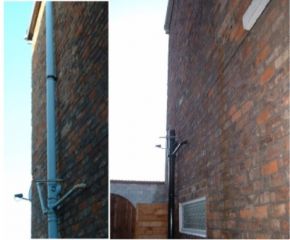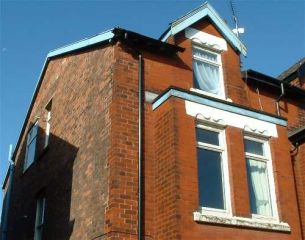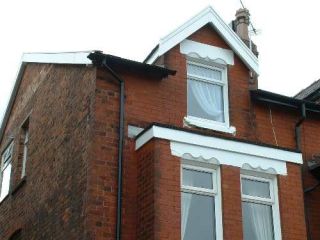The outside appearance of your house can be improved dramatically with a good application of paint, but before painting it is best to assess if replacement is more economically viable than painting!
Plastic rainwater down pipes for instance are difficult to paint as you need to prepare the surface, undercoat then apply the top coat of paint. This is very time consuming and replacing a down pipe is often far easier, cheaper and looks far better, some manufacturers make them in the following colours- Black, Brown and Grey.

This picture shows that the vent on the soil pipe reaches above the level of the roof which is a three storey house, this would make painting it very difficult. I opted for replacing the vent section of the stack with an air admittance valve and then painted the other section to the floor.
Some wood work can be covered with PVC profiling, this should be done where possible as it removes the need for periodic painting, PVC comes in several colours now, mainly white but you can normally get Mahogany or Oak, new colours are being produced all the time so check with your local Distributor.
On the front of this house I did a combination of painting and PVC cladding, in most cases it is far easier and quicker to clad with PVC rather than paint!

Here you can see that the wood work has not been painted for some considerable time, If the wood is rotten it is best to replace it but if it is sound you can merely clad over it.

The apex was removed as it was rotten and replaced with PVC, Taurus skirting board made from PVC was used for effect on the front. There were gaps where the windows met the walls of the property so PVC cloaking profile was cut to fit and held in place with silicone.
Painting walls
Brick walls do not normally need painting, they look far better if they are cleaned and treated with a good quality waterproofing solution. The wall can normally be cleaned by brushing with a stiff brush, be sure to wear goggles and a dust mask as particles will fly everywhere. If it is a small wall it would be far easier to use a pressure washer and some specialist brick cleaning/patio cleaning solution. DO NOT USE A PRESSURE WASHER ON A LADDER! If any pointing becomes loose or drops out see re-pointing. Remove any mould with a scraper and treat with a fungicide, then rinse it off the next day.

If the wall has been rendered and cracks have appeared they will need filling before painting, paint some external PVA bonding into the cracks as this will help the filler to stick. If the cracks are fine I recommend using a special exterior filler but if they are more than say 2mm mortar would probably be best.
If the wall is chalky or powdery it will need sealing first with a stabilising solution.
Choose your paint wisely
Ever heard the expression " you get what you pay for"?
Although there are many different Paint manufacturers, some are better than others, the only time I ever visit the Large do it yourself stores is to purchase paint, not because they are cheap but because they stock the best brands. The difference between a good paint and not so good paint is evident when you come to use it. Some of the best manufacturers make One coat emulsion and surprisingly it does cover most colours in one coat, the cheaper versions which claim to be one coat generally need 2 or 3 coats- false economy I believe.
Before painting the masonry it is best to prepare any woodwork such as windows or doors first. Most wood can be painted over by slightly sanding it with some sand paper and then giving it a wipe with a rag with a little white spirit on it. If the existing paint has bubbled it will need removing, this is best done with a electric hot hair gun and a scraper, these guns strip paint for fun. KEEP IT WELL AWAY FROM THE GLASS AS THERMAL SHOCK CAN BREAK THE GLASS! If any of the wood is rotten but not enough of it to warrant replacing the whole window it is best to remove all of the rotten wood and purchase a wood repair kit!
Replace any missing putty which is sealing the window or if large gaps between the window and walls appear you can cover these with PVC cloaking profile by sticking them in place with silicone.
Know your limitations, if you are a sloppy painter and get it all over yourself and splatter everything make sure you mask an items that don't need painting and place a dust sheet on the ground in case of any drops. If you are capable and don't splat everything in sight you don't need to mask surrounding areas. I suggest either a 4 inch or 6 inch masonry brush.
If you are applying rough masonry paint then the special brush is advised. It is easiest to start painting at the top of a wall and work your way down wards. Apply a good even coat and ensure not to overload the brush, brush the paint out in all directions to ensure you don't get lines in the paint. A paint kettle is advised as it is a lot easier to hold especially as masonry paint normally comes in 5 litre tins!
After Painting the walls you can paint the woodwork, ensure the wood is dry before painting. The amount of time you spend preparing the woodwork the better the final finish will be, It is best to give 2 coats of undercoat and a coat of gloss. One coat gloss and undercoat should be avoided as the results are not satisfactory for outside! If you are a sloppy painter it is a good idea to mask around the windows, or use a paint guard. Personally I prefer to take my time and not use any such implements as they are too time consuming, It is far easier to take your time and practice cutting in by holding the brush at the appropriate angle.



